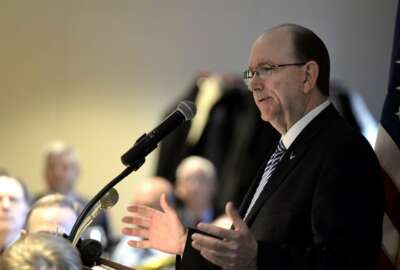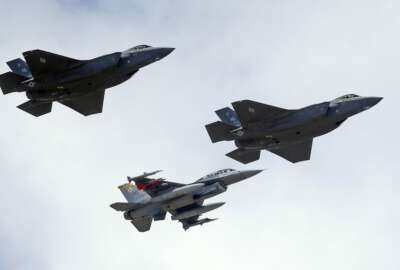
Air Force looks to build ‘big idea pipeline’ to expand industrial base
Starting this week, the Air Force says it wants to introduce new participants into its supplier base where it will sign one-page contracts with small businesses.
Best listening experience is on Chrome, Firefox or Safari. Subscribe to Federal Drive’s daily audio interviews on Apple Podcasts or PodcastOne.
The Air Force spends north of $40 billion on acquisition and R&D each year, a sum that, in theory, ought to be plenty to sustain a healthy and competitive industrial base.
But one of the service’s big problems, according to its acquisition chief, is that those dollars tend to be concentrated among only a relative handful of major systems. Meanwhile the big investment decisions the Air Force makes to introduce new technologies are several years apart from one another.
“It takes decades between fighters, decades between tankers,” said Will Roper, the assistant secretary for acquisition, technology and logistics. “When the Air Force started off, it was years — in the small single digits. A fundamental flaw that we have in working with the industry base is that we don’t do enough big ideas, enough prototypes, enough diversifying, because the frequency of our awards is too slow.”
No ‘valley’ in a pipeline
Among the disadvantages in the Air Force’s habit of making large, infrequent spending decisions is that there aren’t many opportunities for new competitors to gain a foothold in the market, Roper said.
So, as a remedy, he said the service will create a “big idea pipeline” in which it will commit itself to funding a greater number of technologies and at a faster clip. And he suggested the Air Force’s funding commitments will go beyond small prototypes: They’ll need more institutional commitment behind them to carry new technologies across the “valley of death.”
“There’s no valley in a pipeline, right? A pipeline keeps flowing. It’s important that we adopt this mentality, because a pipeline is inherently competitive,” Roper told the Air Force Association’s annual winter symposium in Orlando. “We can’t predict the future. If I told you what 2030 would be like … the future is so uncertain that it doesn’t make sense to predict the adversary at that timeframe and then build the Air Force that beats them. That’s too risky and it’s too prescriptive. We need to be creating new concepts constantly that challenge what our opponents think about us, that impose cost, that make them react to us, that pull them off their game plan. And right now there’s not a concerted effort to do it.”
Related Stories
Wilson told last week’s conference the study is “very close” to being finished, and Roper suggested the service planned to use the results to inform its “big idea pipeline.”
As one example of how the new approach might feed into real-world systems, he offered the forthcoming Advanced Battle Management System.
ABMS is the Air Force’s notional replacement for J-STARS, the airborne surveillance system it uses to track enemy forces on the ground. Instead of replacing one aging surveillance airplane with a newer airframe, it’s decided to try to deliver the same capabilities via a networked system of sensors that it hopes will be more survivable in future combat scenarios.
“We are going to have to break it up and put part of it in space, part of it in air, potentially have an attritable layer, and have the networking and data sharing amongst all of it so that it works as one organism, even though it really is a separate diversified family of systems,” he said. “We’ve never done anything like that. So has to be shepherded differently, because it will bring in next gen technology, but in a framework that will move forward into a program of record.”
Using savings from weapons sustainment
Feeding the pipeline will require some money beyond the $2 billion the Air Force already spends on science and technology. And Roper says he hopes to find much of it by squeezing savings out of the service’s existing weapons system sustainment costs, which currently make up about 70 percent of the total lifecycle spending for an average weapons platform.
Cutting those costs by as little as 5-10 percent would go a long way toward making room for additional “big ideas” that would not otherwise see the light of day in the Air Force’s current funding portfolio, he said.
And Roper said there’s good reason to believe there are a significant number of dollars to be wrung from sustainment, because even though the Air Force’s logistics workforce is “defying gravity” with the quality of their work, the depots they work in are not always equipped with state-of-the-art technology and business processes.
Latest Defense News
But increasing the Air Force’s uptake rate for new technologies isn’t just a matter of making room for them in its budget.
Roper said the service realizes it also needs to make itself a much more attractive customer for smaller, non-traditional vendors, and that its acquisition workforce needs to become comfortable working with multiple types of companies — from huge defense primes to small startups.
As one way to address the latter group, the service is planning an event in New York later this week where it will sign $40 million in contracts with small firms that make dual-use products. At the “Pitch Day,” each company the Air Force selects out of a group of 60 will be given a contract that’s no longer than one page, and the service will pay the firms on the same day, using government purchase cards.
“Pitch day will be our first entree to have an open door to nontraditional companies with dual-use technologies,” Roper said. “But it needs to be more than that. Prototyping is helping our defense industry base, but we need to do more than that. We will shepherd through the first generation of big ideas, but we need to be discussing those at every AFA.”
Read more of the DoD Reporter’s Notebook
Copyright © 2025 Federal News Network. All rights reserved. This website is not intended for users located within the European Economic Area.
Jared Serbu is deputy editor of Federal News Network and reports on the Defense Department’s contracting, legislative, workforce and IT issues.
Follow @jserbuWFED








